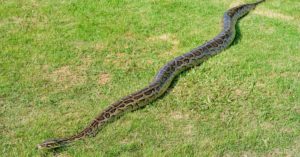Are there alligators in Mobile, AL? Absolutely.
There are about 70,000 alligators living throughout Alabama. These reptiles live in ponds, lakes, canals, rivers, swamps, marshes, and almost any body of water they can find. These ancient predators can range from a few feet long to over 10 feet in length.
If you live in Alabama or are considering paying a visit, you should learn everything you can about staying safe around alligators. Is it safe for you to get in the water? Can you kayak without worry? Read on to find out.
Alligators in Mobile
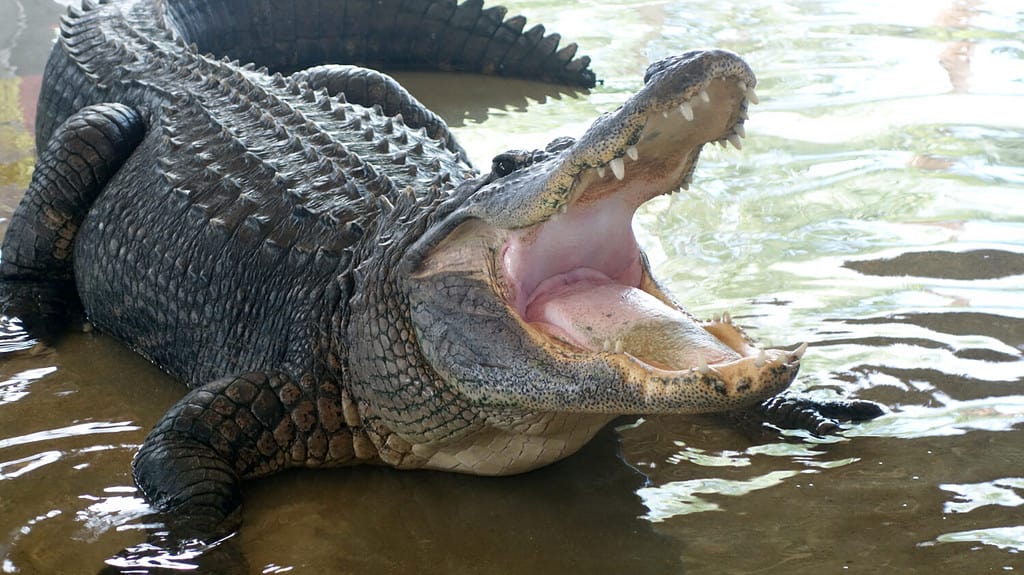
Alligators live throughout the southeastern United States.
©Ernie Hounshell/Shutterstock.com
Alligators are native to the southeastern United States, such as Florida, Louisiana, Mississippi, North Carolina, South Carolina, Arkansas, Oklahoma, Georgia, and Alabama. You can also find these giant reptiles swimming throughout eastern Texas. Their favorite habitats include swamps, marshes, lakes, slow-moving rivers, and freshwater. Alligators can live on water and dry land but thrive in moving water.
Alligator Habitats
These giant carnivorous reptiles live along the edges of lakes, ponds, or rivers. They usually dig burrows to rest and avoid extreme weather.
There are two recognized species of alligators worldwide: the Chinese alligator, which is native to eastern China, and the American alligator, which is native to the southeastern United States. The only species present in Mobile, AL, is the American alligator.
How Big Are Alabama’s Alligators?
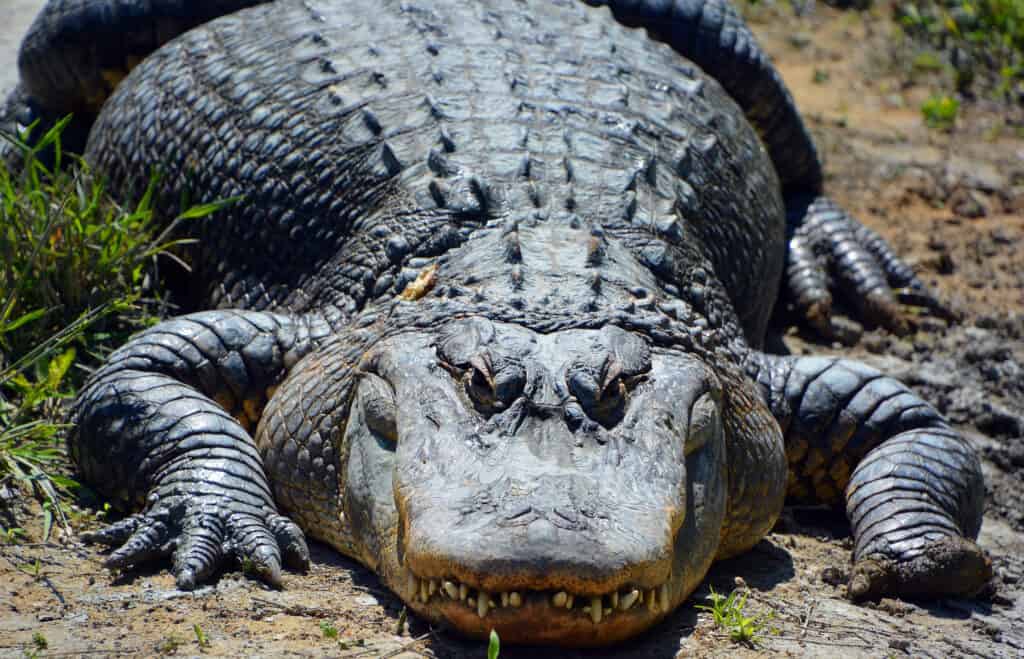
Male alligators can grow to be 11 to 15 feet long, and sometimes they get even bigger.
©meunierd/Shutterstock.com
Now you know that there are alligators in Mobile, AL, but how big are they? Are they little 3-foot alligators swimming around or humongous 10-foot beasts? The answer is both.
There are all different sizes of alligators in Alabama. These reptiles can grow to be quite large. On average, male alligators can grow to be 11 to 15 feet long. And females, which are typically smaller, can grow to be eight to ten feet long.
Record-Breaking Alligators
One of the biggest alligators on record measured 19 feet and 2 inches long. That’s longer than a compact car. Along with being lengthy, alligators are also quite heavy. A full-grown alligator can weigh anywhere from 500 to over 1,000 pounds. But that doesn’t mean all alligators reach massive sizes. The size of an alligator varies depending on its habitat, genetics, and food availability.
When Are Alligators Most Active?
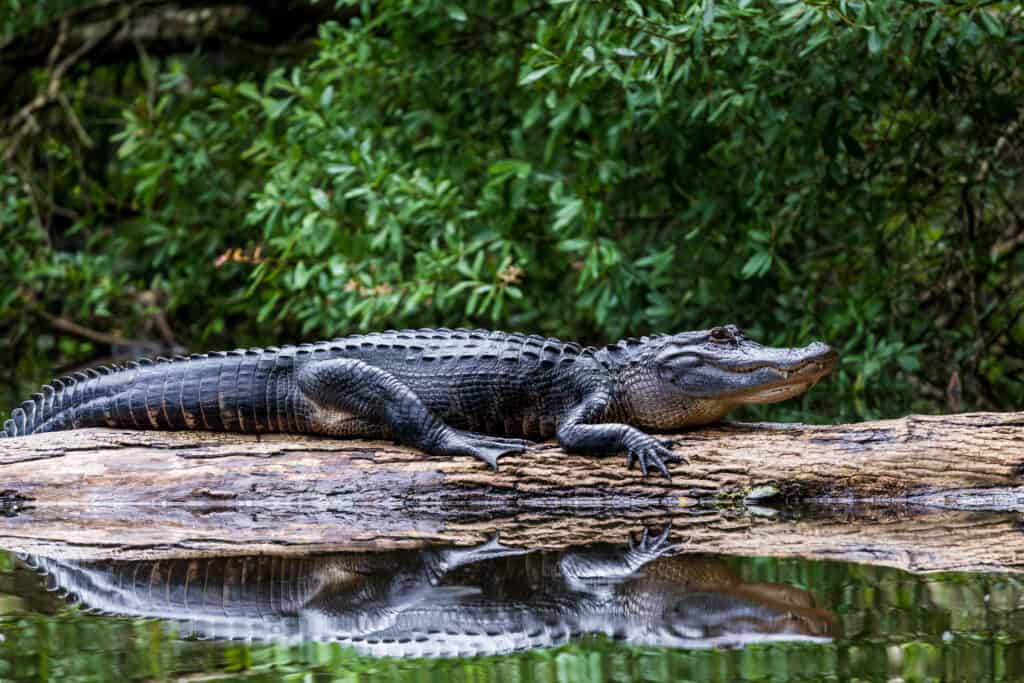
Alligators are most active during warmer weather, especially at dusk and dawn.
©iStock.com/Joe Pearl Photography
Avoid the water at dusk and dawn. These are feeding times for alligators.
Alligators are active during the beginning and end of the day because they’re hungry and because of the changing temperature. Rising temperatures increase the alligator’s metabolism, which causes them to go out and seek prey.
Most Dangerous Time of the Year
Alligators are most active during the spring and summertime. Their peak activity occurs during springtime courtship, mating, and nesting seasons. During mating season, male alligators become more aggressive as they search for a mate. And once the nesting season begins, females will fearlessly protect their nest. Do yourself a favor, and take a moment to learn what alligator nests look like.
What Do Alligator Nests Look Like?
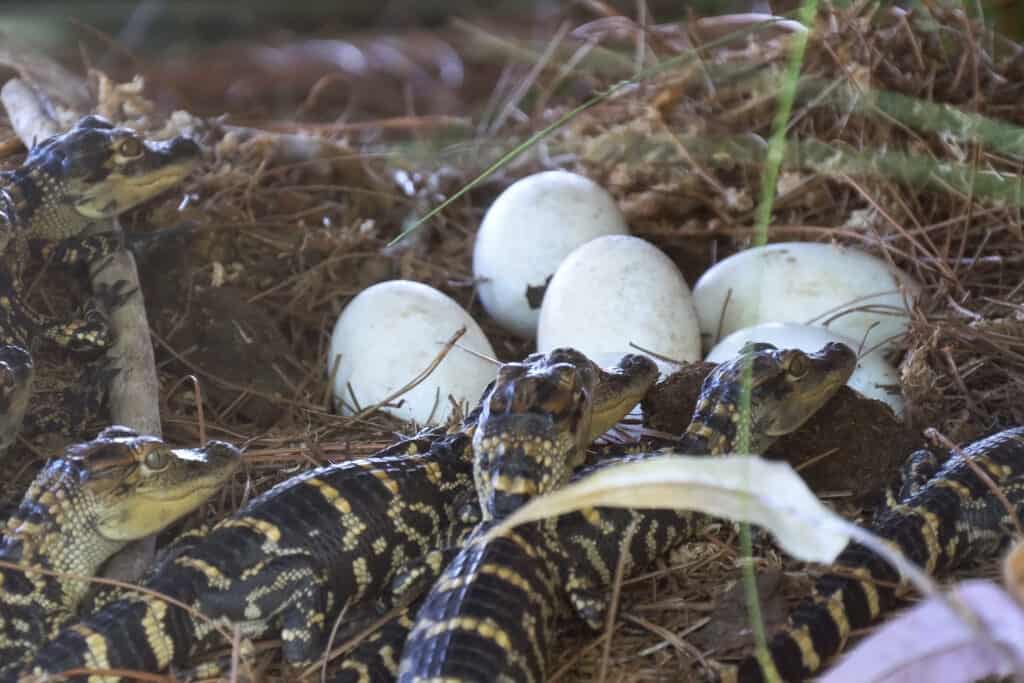
During alligator nesting season you have to be extra vigilant for nesting spots.
©DimaSid/Shutterstock.com
Identifying and avoiding alligator nests is crucial if you’re going to Mobile during nesting season. If you accidentally stumble upon an alligator nest, you might have an angry alligator mom come out to pick a fight.
Even though they’re large, it can be easy to miss an alligator’s nest if you don’t know what you’re looking for. These reptiles make their nests out of rotting vegetation. They usually look like mounds, but sometimes they’re less defined.
The National Park Service has these photos of alligator nests. Notice how they look like big humps of vegetation. Sometimes they’re more defined than others. While you’re out, stay away from any potential nests. And if you see a baby alligator, be careful, its mother is likely nearby.
Surviving on Sunlight: Ectothermic Nature of Alligators
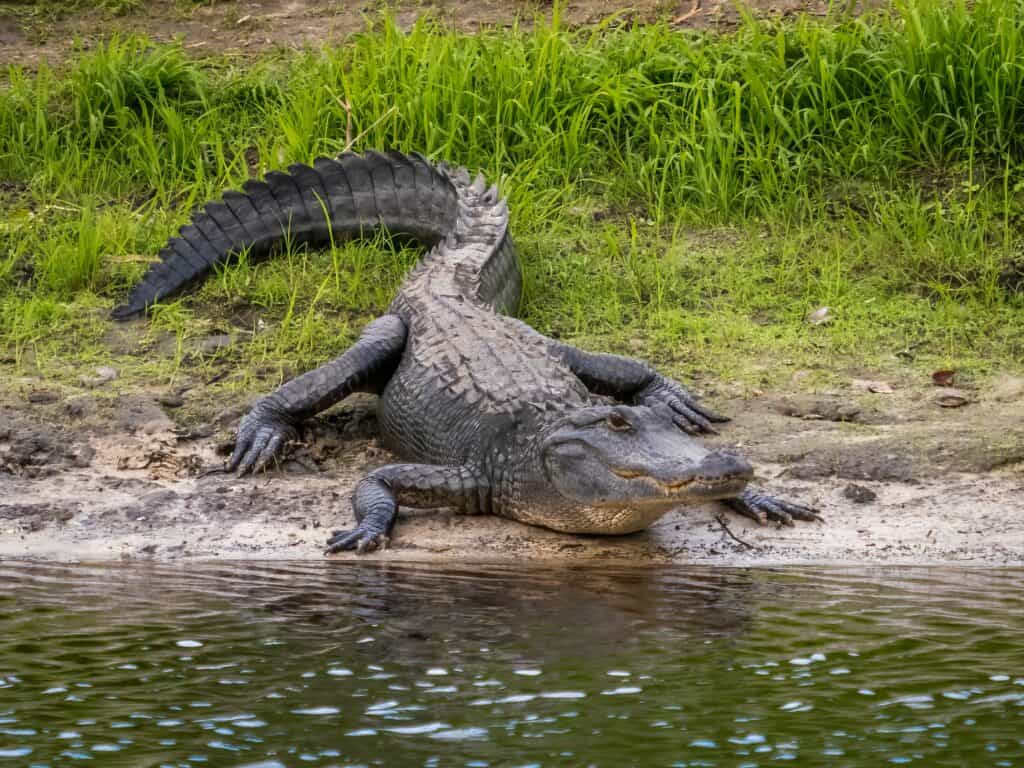
Alligators are ectothermic; they rely on outside sources of heat to control their body temperature.
©Jim Schwabel/Shutterstock.com
Alligators can not generate their own body heat like humans do. That’s because they’re ectothermic creatures. They rely on outside sources of heat to control their body temperature. The temperature of an alligator’s body matches the temperature of its surroundings. If the weather is warm, the alligator’s body will be warm. If it’s chilly outside, the alligator will be chilly too.
Alligators in Cold Weather
Alligators are most active when they’re nice and warm. They become less active and slow down if it gets too cold out. Sometimes they even enter into a state similar to hibernation. During this time, they’ll rest and conserve energy until it starts to warm up again. Once the sun is out, alligators love finding a spot to bask. They’ll lie in the sun to soak up its warmth.
Alligators in Hot Weather
Alligators begin looking for places to cool off if it gets too hot. They might rest under a shady tree or get in the water.
Is It Safe to Swim or Kayak on Mobile?
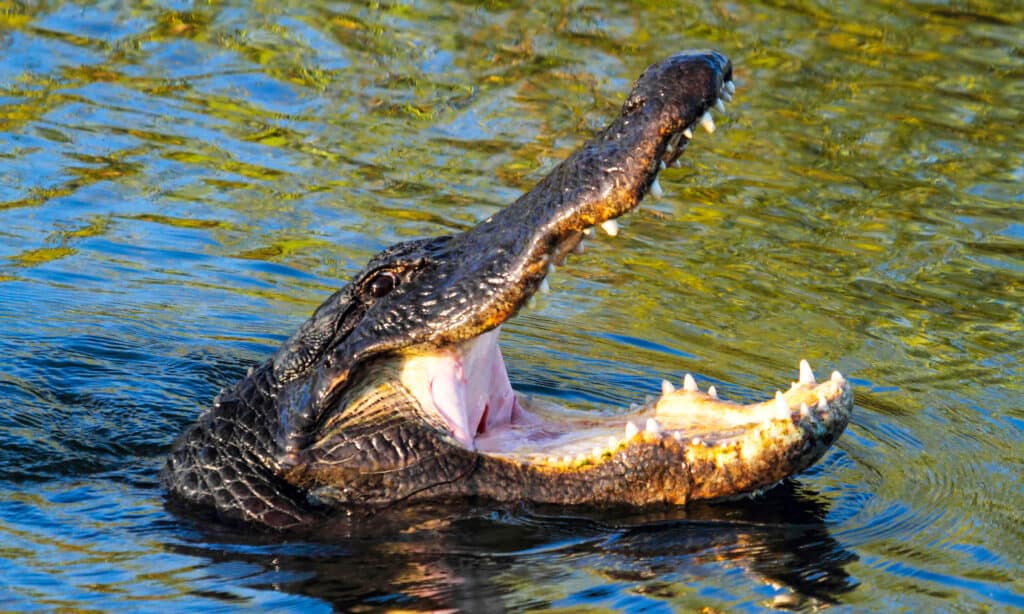
Anytime you swim or kayak in a body of water with alligators, there’s some level of risk.
©Steve Byland/Shutterstock.com
Are you safe to get in the water when you’re in Mobile, AL? There’s always a risk whenever alligators are present in a body of water. But plenty of people make the choice to enjoy the waters. They just do so responsibly, to help minimize the chances of an attack.
Alligators are dangerous wild animals, but they’re not out to get you. Attacks on humans are extremely rare. These reptiles usually avoid people at all costs because they find us scary. If you’re swimming in safe locations and taking all of the necessary precautions, you can have a great time. But no matter what, always remember alligators are not an animal to be taken lightly. If an alligator is threatened, provoked, or nesting, you could be at risk of an encounter.
Alligator Risks
While alligators rarely attack people, there are instances where they have done so. Alligators can harm or attack swimmers and kayakers. Just check out this video of an enormous alligator chasing after a kayaker in Alabama. It’s likely this alligator was provoked or at some time fed by a person. When alligators are angry or complacent, it’s a danger to us.
There’s also the news story about what happened with the alligator and two women kayaking in Alabama. Two friends were kayaking in Alabama when an alligator capsized them! They swam to safety, but it was a scary experience, to say the least. These videos are reminders that wild animals are just that — wild. They can behave in unpredictable ways. The best way to stay safe around alligators is to give them their space.
How to Handle Alligator Encounters
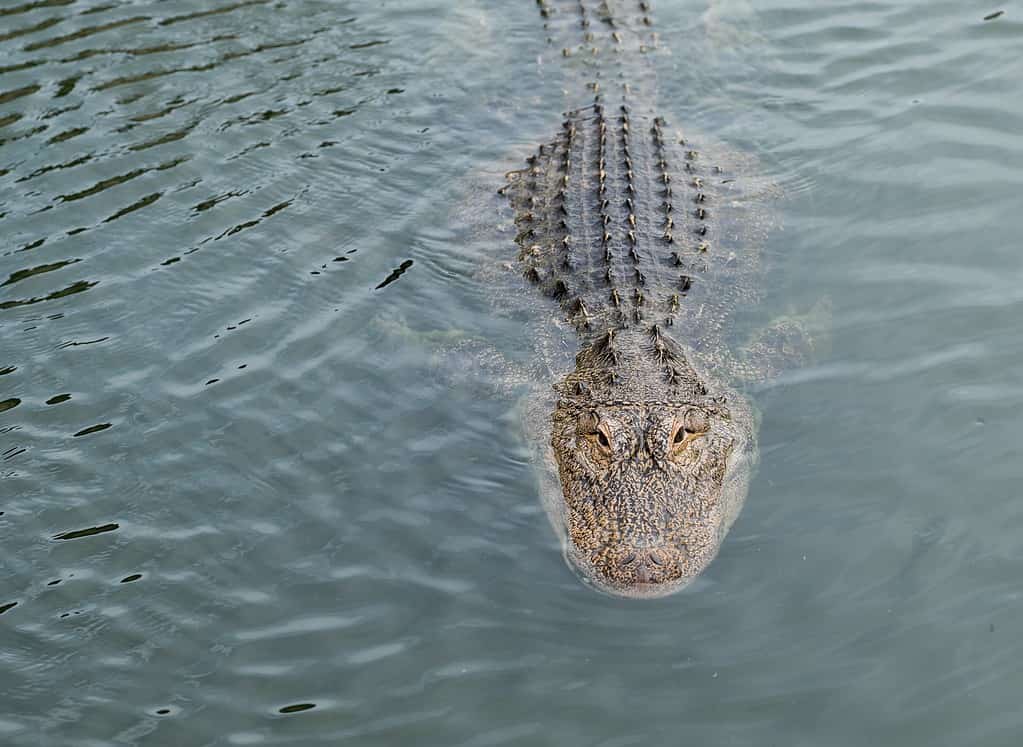
If you encounter an alligator, give it plenty of space.
©David Louis Tiffany/Shutterstock.com
If you encounter an alligator while swimming or kayaking, stay calm and give it space. Don’t go closer for a photo opportunity. Find a way to get out of the water, giving the alligator plenty of space and seeking higher ground. If you encounter an aggressive or dangerous alligator, alert local authorities immediately.
Preventing Problems: Alligator Safety Guidelines
Thankfully, by following safety guidelines and maintaining a safe distance from alligators, you can lower the risk to personal safety. For starters, never approach, feed, or provoke an alligator. An alligator that accepts human food is more dangerous than a wild alligator. And no matter what size they are, give these animals their space. Always keep a safe distance of at least 100 feet away.
Do’s and Don’ts
When you’re launching your kayak, look around. Are you in a known alligator habitat? Talk to local authorities and wildlife agencies to find the best and safest places to enter the water. Stay informed about alligator sightings, especially when it’s nesting season. And avoid swimming or engaging in water activities during dusk or dawn, as alligators are most active at these times.
Final Thoughts on Alligators in Mobile
Now you know that there are alligators in Mobile, AL, and they can grow to be quite large. Some can grow to be over 10 feet long and weigh hundreds of pounds! Attacks on humans are pretty rare. However, they can happen. These carnivorous reptiles can cause fatal injuries, but that doesn’t mean you have to be afraid.
Sure, it’s good to have a healthy fear of alligators. But it’s also good to know how they behave and where they live. The more you know about wildlife, the easier it is to enjoy the great outdoors safely. To protect yourself and your friends, always talk to local authorities and wildlife agencies about the best and safest places to swim. And if you see an alligator nest, stay far away!
The photo featured at the top of this post is © iStock.com/Cindy Larson
Thank you for reading! Have some feedback for us? Contact the AZ Animals editorial team.



